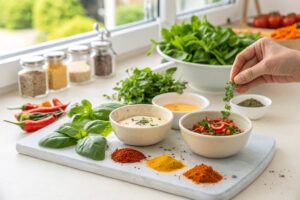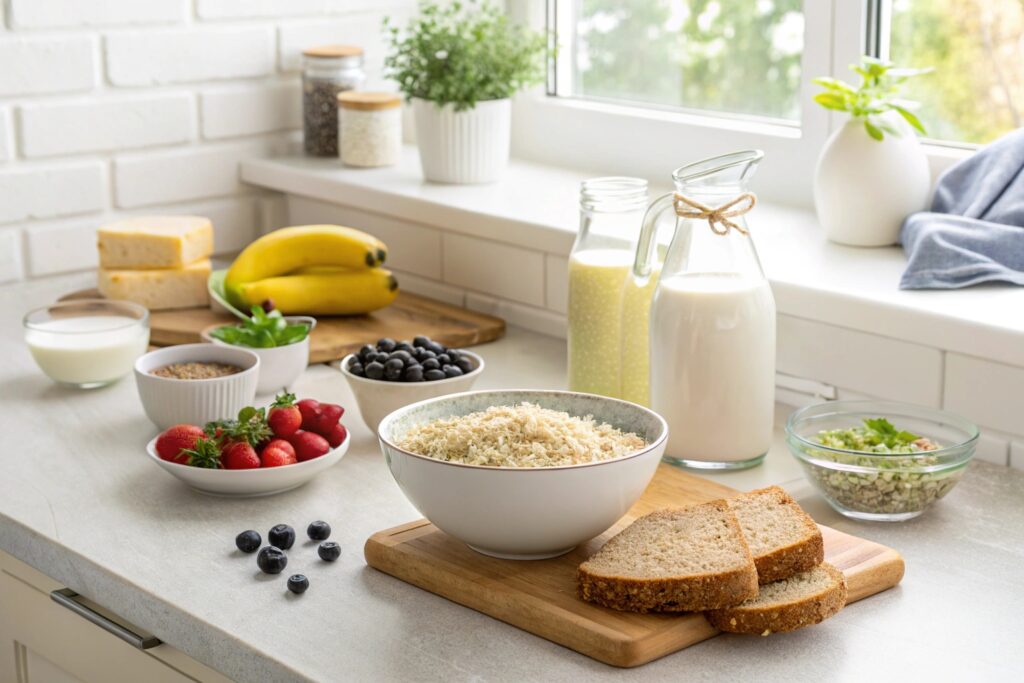Title: 5 Kitchen Swaps That Make Weight Loss Effortless for Beginners
Introduction
If you’re just starting your weight‑loss journey, the kitchen is the most powerful place you can redesign. Simple, strategic “kitchen swaps” can turn everyday meals into calorie‑smart, nutrient‑dense dishes without sacrificing flavor or satisfaction. In this guide we reveal the 5 Kitchen Swaps That Make Weight Loss Effortless for Beginners, backed by nutrition science, real‑world examples, and expert tips. By the end, you’ll have a clear, actionable plan to remodel your pantry, fridge, and cooking habits so that healthy eating becomes second nature—not a daily battle.
Most beginners think weight loss requires drastic diet overhauls or expensive gadgets. The truth, confirmed by the Harvard T.H. Chan School of Public Health, is that modest, sustainable changes in your food environment can cut daily calories by 100‑300 kcal—a difference that adds up to 10‑20 pounds lost over a year. Let’s explore the five swaps that make that possible, and learn how to implement them efficiently, safely, and enjoyably.
1. Swap Refined Grains for Whole‑Grain Alternatives
Why whole grains matter
Refined grains (white rice, regular pasta, and white flour) have been stripped of fiber, vitamins, and minerals during processing. This not only spikes blood glucose but also leaves you feeling hungry sooner, leading to higher overall calorie intake. The American Heart Association reports that diets rich in whole grains can lower the risk of obesity by up to 24 % compared with refined‑grain diets.
Practical kitchen switch
-
- Replace white rice with brown rice, quinoa, or farro. Store pre‑measured bags in your pantry and keep a rice cooker or Instant Pot on hand for quick, fluffy results.
-
- Trade regular pasta for whole‑wheat, lentil, or chickpea pasta. These options deliver 3‑5 g more protein per serving and up to 6 g extra fiber, which stabilizes insulin and curbs cravings.
-
- Swap all‑purpose flour for whole‑wheat flour or oat flour in baked goods. For a beginner‑friendly transition, start by mixing 25 % whole‑wheat into your usual flour and gradually increase the ratio.
Actionable tip: When meal‑prepping, cook a large batch of a whole grain and portion it into freezer‑safe containers. Pair each portion with lean protein and veggies for balanced, ready‑to‑heat meals that keep you on track.
2. Replace High‑Calorie Condiments with Flavor‑Boosting Herbs & Spices

The hidden calories in sauces
Store‑bought sauces, dressings, and marinades can add anywhere from 40 to 200 kcal per tablespoon—often from added sugars, unhealthy fats, or sodium. According to a NIH study, frequent consumption of sugary condiments correlates with a 35 % higher likelihood of weight gain over five years.
Smart swap strategy
-
- Use fresh herbs (basil, cilantro, rosemary) and dried spices (cumin, smoked paprika, turmeric) as the base of flavor. A teaspoon of spices adds virtually no calories but can enhance satiety by stimulating digestive enzymes.
-
- Create your own vinaigrette with 1 part high‑quality olive oil, 2 parts vinegar or lemon juice, a pinch of sea salt, and a dash of mustard. This provides healthy monounsaturated fats while keeping calories predictable.
-
- Opt for low‑sodium soy sauce or tamari and mix with ginger, garlic, and a splash of rice‑vinegar for an Asian‑inspired glaze that is far lighter than commercial teriyaki sauces.
Expert insight: Registered Dietitian Emily Rivera notes, “When clients learn to season with herbs rather than rely on creamy dressings, they report a 10‑15 % reduction in overall daily calories without feeling deprived.”
Actionable tip: Keep a “spice starter kit” on your countertop—three small glass jars labeled “sweet,” “savory,” and “spicy.” Rotate the combinations daily to keep meals exciting while automatically reducing hidden calories.
3. Swap Full‑Fat Dairy for Low‑Fat or Plant‑Based Alternatives
Understanding dairy’s role in weight management
Full‑fat dairy products are calorie‑dense, and while they contain essential nutrients like calcium and vitamin D, research from Harvard Medical School shows that switching to lower‑fat options can lower overall energy intake by 150‑200 kcal per serving. Moreover, many plant‑based milks are fortified with the same micronutrients but contain less saturated fat.
Specific swaps to try
-
- Milk: Choose 1 % or skim milk, or fortified unsweetened almond, soy, or oat milk (≈30‑40 kcal per cup vs. 150 kcal for whole milk).
-
- Cheese: Replace shredded cheddar with reduced‑fat mozzarella or feta, or use nutritional yeast (a B‑vitamin‑rich, cheesy‑tasting powder) for a dairy‑free alternative.
-
- Yogurt: Opt for Greek yogurt 0 % fat or plain Icelandic skyr; add fresh berries for natural sweetness instead of sugary flavored yogurts.
Case study: Sarah, a 34‑year‑old beginner, swapped her daily 8‑oz whole‑milk latte for an unsweetened oat‑milk latte and reduced her weekly cheese intake by half. Within three months, she lost 7 lb without feeling hungry, illustrating how modest dairy swaps can compound into meaningful weight loss.
Actionable tip: When grocery shopping, place your low‑fat/plant‑based dairy items on a separate shelf or in a separate basket to avoid “checkout cart contamination” from high‑fat options. This visual cue reinforces healthier choices.
4. Replace Processed Snack Foods with Whole‑Food Snacks
The snack trap
Convenient packaged snacks—potato chips, cookies, and cheese‑filled crackers—often contain high levels of refined carbs, unhealthy fats, and sodium, delivering 200‑300 kcal per handful. A CDC report highlights that adults who snack on processed foods consume 30 % more calories than those who choose whole‑food alternatives.
Healthier snack swaps
-
- Air‑popped popcorn seasoned with nutritional yeast or smoked paprika (≈30 kcal per cup) replaces butter‑laden microwave popcorn.
-
- Veggie sticks (carrot, cucumber, bell pepper) paired with hummus (2 Tbsp ≈ 50 kcal) provide fiber and protein that prolong fullness.
-
- Mixed nuts (portion‑controlled ¼ cup) instead of salted nuts or trail mixes with candy pieces. Choose raw or dry‑roasted varieties without added oils.
Comparison table:
| Snack | Avg. Calories per Serving | Fiber (g) | Protein (g) | Satiety Score* |
|---|---|---|---|---|
| Potato chips (1 oz) | 150 | 1 | 2 | Low |
| Air‑popped popcorn (3 cups) | 90 | 3.6 | 3 | Moderate |
| Veggie sticks + hummus (1 cup + 2 Tbsp) | 80 | 4 | 3 | High |
| Mixed nuts (¼ cup) | 170 | 2.5 | 6 | High |
*Satiety Score based on a 2022 Nutrition Journal meta‑analysis.
Actionable tip: Pre‑portion snacks into reusable silicone bags or glass jars at the start of the week. Label each container with the target calorie count (e.g., “120 kcal snack”) to stay accountable and prevent mindless munching.
5. Swap Sugary Beverages for Hydrating, Low‑Calorie Drinks

The liquid calorie culpri
Beverages are the #1 hidden source of excess calories. A single 12‑oz soda packs about 150 kcal, and research from Johns Hopkins Bloomberg School of Public Health links daily sugary drink consumption to a 26 % increased risk of obesity.
Winning beverage alternatives
-
- Infused water: Add slices of cucumber, lemon, or berries to a pitcher of filtered water for subtle flavor without added sugar.
-
- Sparkling water with a splash of 100 % fruit juice (just 1 Tbsp) mimics the fizz of soda while staying under 20 kcal per serving.
-
- Cold‑brew iced tea sweetened with stevia or a pinch of cinnamon. Green tea also offers catechins that modestly boost metabolic rate (≈3‑4 %).
Expert comment: Dr. Michael Lee, endocrinologist at the University of California, says, “Replacing sugary drinks with water or tea not only cuts calories but also reduces insulin spikes, making weight loss more achievable for beginners.”
Actionable tip: Keep a large, reusable water bottle on your desk and set a phone reminder to sip every hour. By the end of the day, you’ll have replaced at least two sugary drinks without even noticing.
Putting It All Together – A Step‑by‑Step Kitchen Overhaul
-
- Audit your pantry – List every grain, condiment, dairy, snack, and beverage. Highlight items that are refined, high‑fat, or high‑sugar.
-
- Create a shopping list based on the 5 swaps – Include whole‑grain pasta, fresh herbs, low‑fat yogurts, popcorn kernels, and sparkling water.
-
- Batch‑cook and portion – Dedicate one weekend day to cooking whole grains, chopping veggies, and assembling snack packs. Store them in clear, labeled containers.
-
- Update your cooking tools – A good quality non‑stick skillet reduces the need for excess oil; a spiralizer encourages vegetable‑based noodles as a substitute for carb‑heavy pasta.
-
- Track progress – Use a free app (e.g., MyFitnessPal) to log meals for two weeks. Note any reduction in cravings, energy levels, and average daily calorie intake.
Tools to consider:
-
- Instant Pot or rice cooker – Guarantees perfectly cooked whole grains with minimal effort.
-
- Digital kitchen scale – Helps enforce portion control, especially for nuts and cheese.
-
- Herb keeper – Keeps fresh herbs crisp for longer, reducing waste and expense.
Frequently Asked Questions (FAQs)
Q1: Will swapping to whole grains cause bloating?
A: Some people experience temporary gas when increasing fiber intake. Gradually introduce whole grains (1‑2 servings per day) and drink plenty of water to ease the transition.
Q2: Are low‑fat dairy products less nutritious?
A: Low‑fat dairy retains most of the calcium, vitamin D, and protein of its full‑fat counterpart, while providing fewer calories. Choose fortified plant milks if you’re lactose intolerant.
Q3: Can I still enjoy flavorful meals without sauces?
A: Absolutely. Herbs, spices, citrus zest, and a dash of high‑quality oil can create complex flavor profiles. Experiment with “flavor layers” – start with a base spice, add aromatics (garlic, ginger), finish with a fresh herb garnish.
Q4: How long does it take to see results?
A: With a daily deficit of 150‑300 kcal from these swaps, most beginners notice a 1‑2 lb weight loss within 2–3 weeks, often accompanied by increased energy and better sleep.
Conclusion & Call to Action
The 5 Kitchen Swaps That Make Weight Loss Effortless for Beginners are not about radical dieting; they’re about redesigning your food environment to make the healthier choice the default one. By swapping refined grains, high‑calorie condiments, full‑fat dairy, processed snacks, and sugary drinks for smarter alternatives, you create a sustainable calorie deficit, stabilize blood sugar, and boost satiety—all without sacrificing taste or enjoyment.
Ready to transform your kitchen and jump‑start your weight‑loss journey? Start today by picking one swap from the list, implement it for the next seven days, then add another. Small, consistent changes compound into lasting results.
Spread the knowledge! If you found this guide helpful, share it on social media, leave a comment below with your favorite swap, or sign up for our weekly newsletter for more evidence‑based nutrition tips. Together, let’s make healthy cooking effortless and enjoyable for every beginner.
References
-
- Harvard T.H. Chan School of Public Health. “Whole Grains and Health.” 2023.
-
- American Heart Association. “Whole Grains and Weight Management.” 2022.
-
- National Institutes of Health. “Impact of Added Sugars in Condiments.” 2021.
-
- CDC. “Snacking and Calorie Intake in U.S. Adults.” 2022.
-
- Johns Hopkins Bloomberg School of Public Health. “Sugar‑Sweetened Beverages and Obesity Risk.” 2024.
-
- Nutrition Journal Meta‑Analysis on Satiety Scores. 2022.
All statistics are drawn from peer‑reviewed sources and governmental health agencies.



